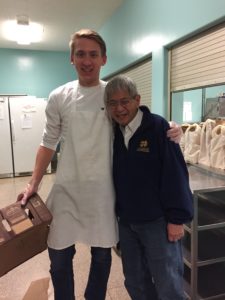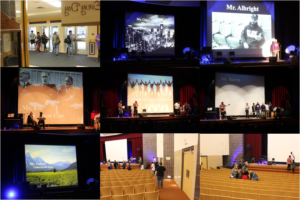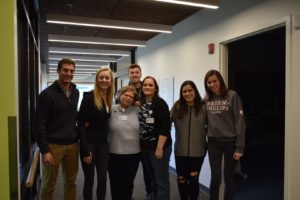Ethnographic Interview Summary
Interview 1:
*** Conducted at ABP on Notre Dame’s campus at 8pm on Sunday 2/26
*** Pictures and video taken, but not included here.
Name: Maria Caponigro
Age: 21 Years Old
From: South Bend
Attended: Adams High School and then Notre Dame – studies Political Science, and Education, Schooling, and Society.
Her HS Extracurricular Activities: Marching Band Drum Major, Jazz Band, Mock Trial, Model UN, NHS, interned at the Mayor’s office.
Her ND Experience: Internship with the Department of Education in D.C.
Occupation: Harrison Primary Center Community School Coordinator. Essentially, this means that she connects people outside the school with the school.
What was the process of choosing your HS?
– Catholic Elementary School 2 through 8th grade
– When it was time to choose a HS, her options were St. Joe, Marian and Adams (it was her neighborhood school)
– She didn’t even consider Riley, Clay, or Washington because they were not in her neighborhood.
– Clay isn’t known to have a lot of high academic rigor, more important to her than the arts, Arts are supplemental, academics was the focus for her family.
– She came up with a list of categories of what she thought was important
– Then she took tours of the schools, and attended open houses with her parents
– They each ranked each school in each category, (academic opportunities, singing and musical instruments // arts programs, diversity, proximity, price.)
– When she did shadow:
o Being able to participate in the classes was important
o So was interacting with teachers
o Being able to see the academic programs that up close made her parents feel better about the academic opportunities
o “It is one thing to read about it on paper, and it is another to experience it.”
o Shadowing gives a taste of what it is like to be in the HS.
What played a big role?
– Her brother went there before her.
o That made a huge difference as she looks up to him and considers them very close
o For her dad, this was a negative, because he saw that her brother wasn’t as involved in the church as much after leaving Catholic school
o The fact that her and her brother both went there makes even more of a difference for her littler siblings, since they have been exposed to it for a while now and have grown up liking Adams – seeing the spirit wear, going to football games.
§ Her siblings are Matt (23), Monica (13), and Mitchell (15)
– The decision not to go to St. Joe was mostly academic. It is easier to do well at St. Joe, because there is an environment of academic performance being more important than other things. More students take AP and honors classes at St. Joe. But, one thing she didn’t like was that St. Joe emphasized competitive academics.
– A plus for private school was the Catholic aspect.
– When she looked at Penn it was just too big of a school
– PROXIMITY was really important to her.
– In the end: Adams was nicely balanced in sports, academics, music,
– She also lived right by Adams (probably 3 blocks away).
– Adams won because it ranked the highest in her criteria and in her parents.
Description of Adams:
– Adams is basically equally minority and white,
– Their IB program is predominately white, rest of school is not.
– Over 50% of students are on free // reduced lunch
– Adams is the IB magnet. In her year, 100 kids did the IB Magnet. It has changed a lot since she was there.
o There were only 15 that were full diploma in the whole school, since then the program has grown a lot.
o Now there are from 150 to 200 involved.
o If you are IB you start on the pre-IB track.
o The people who are really engaged in the academics are in the IB program, she wasn’t in the other classes.
o Not every student is super engaged in their academics; but they do better on average because people know it is the academic magnet.
– The IB program prepared her for HS, but there was no counselor help. She couldn’t’ even apply for certain scholarship because her counselor wasn’t involved.
– The Adams foreign language department is fabulous, and it definitely attracts people to the school.
– She did see fights with relative frequency at Adams.
Among the Students – Stereotypes:
– The perception of students of Clay is that Clay doesn’t have a lot of academic rigor // that kids at clay aren’t challenged.
– The other perception is that people who go to Clay are probably artsy, and probably gay.
– The perception was that Adams students were “stuck up” or “bitches”
Expert Resource:
*** Maria has a job in the school district now, and does research on school choice presently.
– Her research is about school choice and how power theories fit with it.
– The idea is that school choice gives power to parents, particularly in low income families, and she wanted to test if this is actually the case.
o Do parents have power in education if they have school of choice?
– If we have vouchers or charter schools and we have legal protection so you can choose, according to the logic, you should see more parents choosing those (higher quality) schools.
– A majority of Latino families in the United States are Catholic. Currently most Latino families aren’t taking advantage of school choice to send their kids to Catholic schools. Why?
– Maria’s research says that it is because we are not providing proper information to parents in a way that is accurate and accessible.
o We don’t train parents on how to navigate the educational system.
o We shouldn’t tell them what to choose, but teach them what to look for and allow them to receive that information.
– Where people find information is key to that whole issue.
o A lot of low income parents decide where to go to school based on word of mouth.
o Wealthier parents will look at online resources or booklets or school tours,
o “Low income parents will see that information, but not trust it until they hear it from word of mouth.”
– Level of parental education might play into how much parents value academic quality.
– The most visited data point on a website is demographics of a school. ***
– “People who come from low income families tend to go to school based on practical reasons over academic quality” — transportation, where their friends’ kids go, where they know people, if they know teachers there, SAFETY is a huge issue for low income families.
– Her research says that SAFETY is number one issue for almost all parents.
– South Bend city government doesn’t really have a formal way of interacting with schools
o Mayor Pete has been really supportive of the schools.
o Interned for the mayor again last fall and worked for the Director of Community Outreach on a youth task force, that goes around and talks about how to address youth violence.
– Regarding the school “path” – there is an automatic way to go, and this is due to the designation of a feeder school system.
– Most people go to the school that their feeder leads into unless they want a magnet or private school.
o Not heard of a ton of people going to Washington because of the magnet.
o Lots of students go from Kennedy – LaSalle – Adams because those three are the academic magnets.




